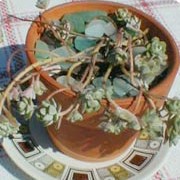 You don’t need a lot of money to have classy-looking container plants.
You don’t need a lot of money to have classy-looking container plants.
I rarely purchase my containers new anymore. Not just because they are expensive, but because most of the time I think they’re ugly. Go to any department store or garden centre and you’re bound to find those awful plastic pots that are meant to look like terracotta (who are they trying to fool) or pots in hideous colours or shapes. It’s not just the styles that I find offensive. They charge an arm and a leg for those mass-produced atrocities. Now, I don’t mind paying good money for stylish containers. However, since I don’t have a proper garden, I rely on containers to get the job done. I’m a greedy person. I have a lot of plants, therefore I need a lot of pots. Over the last several years I’ve used ingenuity and my imagination to come up with stylish yet economical resources for all my planting needs.
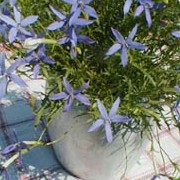 The first place to look if you want a cheap, yet traditional terracotta pot is the second hand store. If you go during the winter, the gardening off-season, you can find used terracotta pots at fairly reasonable prices. Look around and stockpile when you do find a bargain. The closer to planting season you get, the harder it is to find them at a reasonable price. Even the second hand stores will try to gouge you. Used terracotta can actually be superior to new because they already have that aged patina everyone is trying so hard to achieve these days, and they often come in styles and shapes that aren’t produced. Believe it or not, all terracotta pots are not created equal. You will need to clean and sterilize your used pots. They often come with dirt and mineral build up still in them. Even if they are spotlessly clean, they will need to be sterilized using some sort of cleaning agent. The reason being, that the used pots could have been housing a diseased plant and you don’t want to pass that disease onto your own plants. The usual method of sterilization is to soak the pots in a tub filled with 1 part bleach to 10 parts very warm water. As an alternative, I use oxygenated bleach (hydrogen peroxide) or an all-purpose, environmentally friendly cleaner instead of bleach and have had no problems as a result. Scrub the pots clean with a brush. Rinse and lay them out to dry in a rack or a towel.
The first place to look if you want a cheap, yet traditional terracotta pot is the second hand store. If you go during the winter, the gardening off-season, you can find used terracotta pots at fairly reasonable prices. Look around and stockpile when you do find a bargain. The closer to planting season you get, the harder it is to find them at a reasonable price. Even the second hand stores will try to gouge you. Used terracotta can actually be superior to new because they already have that aged patina everyone is trying so hard to achieve these days, and they often come in styles and shapes that aren’t produced. Believe it or not, all terracotta pots are not created equal. You will need to clean and sterilize your used pots. They often come with dirt and mineral build up still in them. Even if they are spotlessly clean, they will need to be sterilized using some sort of cleaning agent. The reason being, that the used pots could have been housing a diseased plant and you don’t want to pass that disease onto your own plants. The usual method of sterilization is to soak the pots in a tub filled with 1 part bleach to 10 parts very warm water. As an alternative, I use oxygenated bleach (hydrogen peroxide) or an all-purpose, environmentally friendly cleaner instead of bleach and have had no problems as a result. Scrub the pots clean with a brush. Rinse and lay them out to dry in a rack or a towel.
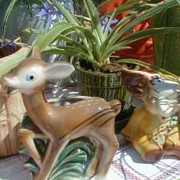 Second hand stores, auctions and garage sales are also good places to find more interesting containers from the last several decades. I’ve purchased many glazed ceramic pots form the 50’s, 60’s and 70’s that are far superior aesthetically to the contemporary offerings, and at greatly reduced prices. I have containers in the shape of cute elephants, deer and lambs even. I have a few that have a bamboo texture on the outside and even come with their own, attached drip tray. Again you will need to clean and sterilize these containers in the same manner as the terracotta pots. In some cases you may need to create a drainage hole in the bottom of the container so that the plant doesn’t drown when you water it. This can be accomplished easily with a drill or Dremel, and a masonry bit. Be sure to wear safety gear when you do this because the dust flies everywhere. Drill a few 1/4″ holes into the bottom of the container so that water can drain out. If you don’t want to modify your objet d’art then you can create drainage for the plant by putting a layer of gravel in the bottom of the container before adding soil and a plant. Another method is to simply slip a plant potted in a plain, plastic container that is slightly smaller, inside the larger, more stylish container. With this method you won’t need a plate to catch the dripping because the outer container will do that job.
Second hand stores, auctions and garage sales are also good places to find more interesting containers from the last several decades. I’ve purchased many glazed ceramic pots form the 50’s, 60’s and 70’s that are far superior aesthetically to the contemporary offerings, and at greatly reduced prices. I have containers in the shape of cute elephants, deer and lambs even. I have a few that have a bamboo texture on the outside and even come with their own, attached drip tray. Again you will need to clean and sterilize these containers in the same manner as the terracotta pots. In some cases you may need to create a drainage hole in the bottom of the container so that the plant doesn’t drown when you water it. This can be accomplished easily with a drill or Dremel, and a masonry bit. Be sure to wear safety gear when you do this because the dust flies everywhere. Drill a few 1/4″ holes into the bottom of the container so that water can drain out. If you don’t want to modify your objet d’art then you can create drainage for the plant by putting a layer of gravel in the bottom of the container before adding soil and a plant. Another method is to simply slip a plant potted in a plain, plastic container that is slightly smaller, inside the larger, more stylish container. With this method you won’t need a plate to catch the dripping because the outer container will do that job.
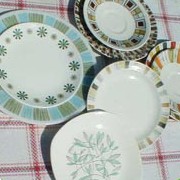 You don’t have to limit yourself to containers that were specifically designed to hold plants. Just about anything made of plastic, galvanized metal, stainless steel, clay or ceramic will work as a plant pot. Once again you will need to clean, sterilize and possibly modify the container for drainage following the same methods above. I have used old buckets, tubs, children’s beach pails, ceramic bowls, vases, teacups and teapots in place of traditional containers.
You don’t have to limit yourself to containers that were specifically designed to hold plants. Just about anything made of plastic, galvanized metal, stainless steel, clay or ceramic will work as a plant pot. Once again you will need to clean, sterilize and possibly modify the container for drainage following the same methods above. I have used old buckets, tubs, children’s beach pails, ceramic bowls, vases, teacups and teapots in place of traditional containers. 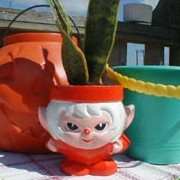 Baskets or old wooden crates found in the garbage can be lined with plastic (poke a few holes in the bottom for drainage) or spagnum moss, filled with soil and planted up. I even collect small saucers or plates with interesting patterns and designs to use as drip trays instead of purchasing the expensive terracotta ones.
Baskets or old wooden crates found in the garbage can be lined with plastic (poke a few holes in the bottom for drainage) or spagnum moss, filled with soil and planted up. I even collect small saucers or plates with interesting patterns and designs to use as drip trays instead of purchasing the expensive terracotta ones.
The possibilities really are limitless, proving that you don’t need a lot of money to have a lot of classy looking container plants. You just need to be willing to expand your concept of what a plant pot is and can be.